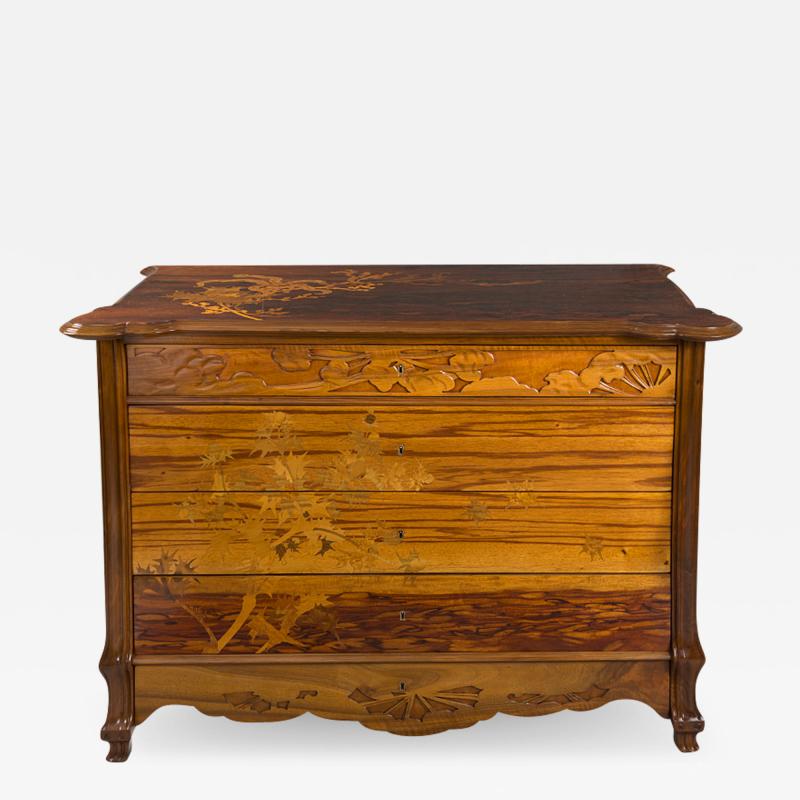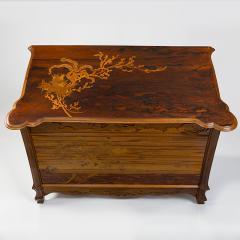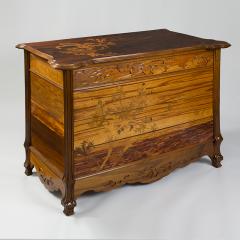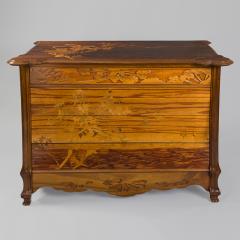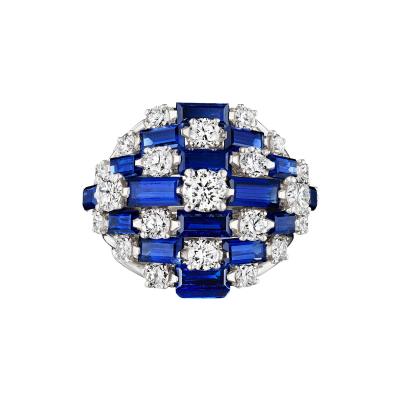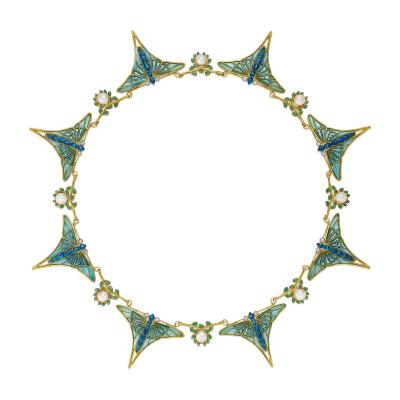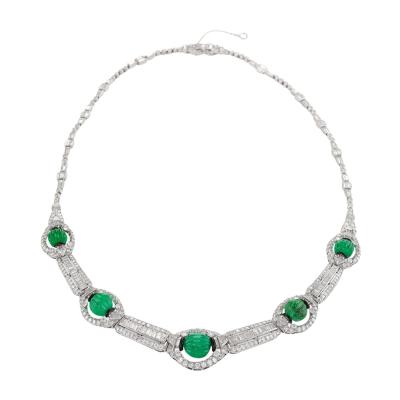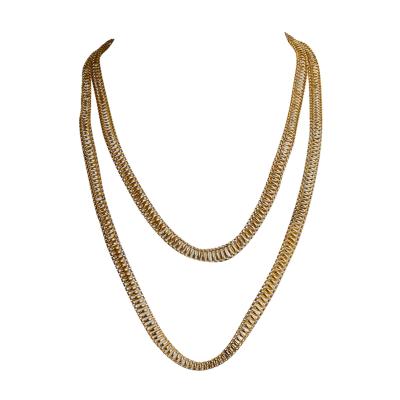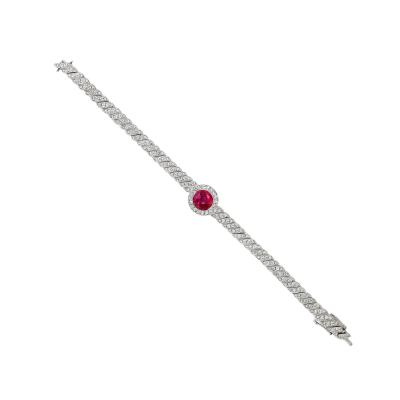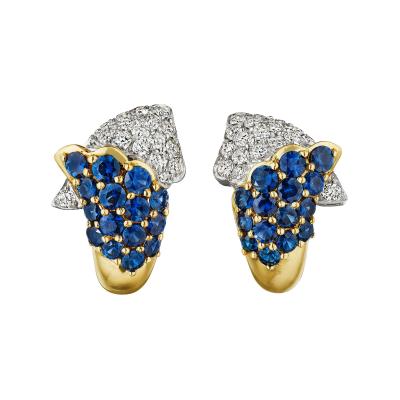"Chardons des Sables" Commode
-
Description
A French Art Nouveau "Chardons des Sables" chest of drawers by Émile Gallé. The "Chardons des Sables" (sand thistle) commode is a moving meditation on mortality. Gallé created this piece in 1903, after he was diagnosed with leukemia. He died the following year. Gallé has rendered a vista redolent of a longing for return. The commode''s central "sand thistle" motif alludes to a passage in Victor Hugo''s poem Les contemplations, Paroles sur la dune (1854): Maintenant que mon temps décroît comme un flambeau Que mes tâches sont terminées; Maintenant que voici que je touche au tombeau Par les deuils et par les années, Je regarde, au dessus du mont et du vallon, Et des mers sans fin remuées, S''envoler sous le bec du vautor aquilon, Toute la toisuon des nuées Et je pense, écoutant gémir le vent amer, Et l''onde aux plis infranchissables; L''été rit, et l''on voit sur le bord de la mer Fleurir le chardon bleu des sables. Now that, like candlelight, my lifetime wanes And my tasks are complete; Now that I, passing years and faced with pains, Find the grave at my feet, I watch, high over mountaintop and vale And ever-surging sea, Before the beak of that vulture the gale, The woolen clouds all flee. So I reflect, hearing the wind''s harsh roar, And the wave''s boundless pow er Though summer smiles, and on the sandy shore, See the blue sand thistle flower. Like Victor Hugo in Les contemplations, Paroles sur la dune, the sand thistle figured on the marquetry frontispiece is towards the end of its bloom season. Most of the flower heads have turned dark brown and three have detached from their rosettes only to blow away in the ocean gale. To understand the extent of Gallé''s thematic dedication, one need only look at a blackened sand thistle leaf located in the center back of the commode top. The leaf is of the same value as the aqueous background, rendering it nearly imperceptible. Though seemingly a superfluous detail, the leaf''s inclusion completes the piece''s narrative: the plant, like the artist, fades into oblivion. Gallé''s pairing of image and poem is steeped in Japanese tradition. Gallé believed that Japanese artists painted with a "spirituel pinceau" (spiritual brush) and that marine plants were "bulleuse calligraphie" (blistered calligraphy). Unlike his previous Hugo-inspired furniture, Gallé has opted not to include the refrains of the poem that inspired this piece in the marquetry. Instead the work itself has become the poem. Gallé had previously synthesized land and sea in his 1889 Flora Marina, Flora exotica jardiniere. While his prior explorations of the theme relied heavily on allegory and ornate high relief carving, the "Chardons des Sables" commode is a prime example of Gallé''s aesthetic maturation into a thoroughly modern artist. Gone are the ink and shellac outlines and the sand-shaded wood. Rather, Gallé has taken advantage of the striations, figuring and coloration of the natural veneer. The "Chardon des sables" commode stands on four short legs with five long drawers in a carcass of walnut. The first and fifth drawer feature umbelliferae friezes. The second to fourth drawer fronts are veneered with marquetry panels showing "Chardon des sables" in front of the sea. The sky background of the second and third drawer utilizes Burmese rosewood. While rays are a cell type present in all hardwoods, woods in which the rays appear as parallel minute dark stripes of wood are rare. This feature, termed "storied rays," are only found in choice species of tropical hardwoods. For the background of the commode''s frontispiece, the ray patterning serves as a secondary pattern to the dominant dark veining. In this way, although the sky and sea are represented by different wood species, the storied rays imbue the piece with a visual harmony. The Burmese rosewood used in the sky was selected so that the height between each striation decreased as it approached the horizon thereby creating a depth of field. The striation terminates two-thirds of the way down the third drawer. The uniformity from this point until the horizon line mimics the way in which clouds merge into a continuous layer in the deep background. The Le Champ du Sang commode, a piece created three years prior to this one, for the Exposition Universelle de 1900, was designed in a similar compositional formula: foreground flowers and low horizon line. The horizon line was articulated as a hard edge with two contrasting pieces of wood spliced together. The stillness of the scene is palpably felt. As opposed to Le Champ du Sang, the Chardons des Sables commode features a remarkably seamless transition between the sky and the undulating ripples of the sea. Recent close examination has confirmed that the pattern was formed by cutting a single piece of veneer using two different methods. This is evidenced by the wood''s ray arrangement. The first quarter of the drawer is uniformly colored with horizontally storied rays. In the undulating dark brown pattern of the bottom three-quarters of the drawer, the ray arrangement becomes varied (horizontally, obliquely and vertically.) Horizontal storied rays only become visible in crown cut veneer where the wood is cut tangentially to the growth ring. Meanwhile, the varied "storied ray" arrangement only becomes visible when the wood is rotary cut, wherein, the log is centered on a lathe and turned against a broad cutting knife set into the log at a slight angle. To create the veneer''s pattern, the wood must have first been rotary cut. The log had to be subsequently removed from the lathe, and a steam-powered band saw had to rip the wood precisely a few millimeters to the left and right of the rotary cut''s terminus. The method used in the fourth drawer was an extremely time-consuming and precise method of cutting-- all done for the sake of capturing the artist''s compelling personal vision. The characteristic dark-veined swirled grain rotary cut pattern combined with the pommele markings present throughout distinguish the wood as Bubinga, a wood sourced from Equatorial Africa. The density of the pommele-figured Bubinga causes a chatoyant (changeable luster) effect. The resultant sheen simulates the way that light dapples across the water, ideal for Gallé''s representation of the ocean. The work stands out not only in its exceptional artistic technique but also marks the culmination of a scientific career. A lifetime as a botanist had given Gallé a penchant for morphological accuracy. Gallé had previously depicted other species of brittle stars, namely the Striped Ophiolepis superba. While Ophiolepis superba features short to non-existent arm spines, Gallé has chosen to depict the long arm spined Ophiothrix fragilis (hairy brittle star). Using an astounding economy of means, Gallé articulated these spines using the natural wood texture of the Cocos nucifera (Red Coconut Palm.) The contrasting red-brown, black and light gray-brown fibrovascular bundles of the Coconut Palm respectively articulate the negative space between the spines, the shadows of each spine, and the delicate mucosal spines themselves. In another instance of material specificity, the bumpy conceptacles (reproductive cavities) on a bladderwrack are rendered by Gallé using birdseye-figured Acer saccharum (Sugar Maple.) Gallé collected and preserved a variety of seaweed and shell specimens while in the Keller villa. Charles Keller (alias Jacques Turbin) was an anarchist, activist, poet and archaeologist. Keller had built a seafront villa in Carnac, Brittany after the excavation in 1862 of the Saint-Michel Tumulus, a megalithic grave mound. He regularly invited Gallé to this seaside retreat, and even when Gallé returned to Nancy, Keller was sure to send new species to add to Gallé''s burgeoning herbarium. Gallé''s choice of motifs on the commode''s top go far beyond scientific interest in morphological accuracy. Integral to Gallé''s macchia is the dissimilarity of the stiff and flexible, the brittle and fluid. Unlike the closely-related sea star, brittle stars have sinuous flexing arms, giving their legs an efflorescent appearance. This quality makes the brittle star an ideal object of representation. Conversely, the thick stem of the star thistle reads to the viewer as kelp in this underwater milieu. At the point in which the marine becomes flora and flora becomes marine, the conceptual unity of the piece reaches its culmination. Hugo, Victor, E. H. Blackmore, and A. M. Blackmore. 2004. Selected poems of Victor Hugo: a bilingual edition. Chicago: University of Chicago Press. #11;Gallé, Emile. 1908. Écrits pour l''art: floriculture, art décoratif, notices d''exposition, 1884-1889. Paris: Renouard. https://archive.org/details/critspourlartflo00gall. #11;#11;Pictured in: The Paris Salons 1895-1914 Volume III: Furniture, by Alastair Duncan, Antique Collectors Club, 1996, page 235.
-
More Information
Documentation: Documented elsewhere (exact item) Origin: France Period: 1900-1919 Creation Date: 1900 Styles / Movements: Art Nouveau Dealer Reference #: F-18720 Incollect Reference #: 339459 -
Dimensions
W. 49 in; H. 35.5 in; D. 26.5 in; W. 124.46 cm; H. 90.17 cm; D. 67.31 cm;
Shipping Information:
We are delighted to offer complimentary overnight domestic (US) shipping on all orders via FedEx and UPS for all jewelry orders. We offer overnight domestic (US) shipping on furniture and decorative arts purchases for a fee, based on the size and weight of the item purchased
Message from Seller:
Macklowe Gallery is the premier dealer of museum-quality 20th Century Decorative Arts, specializing in Tiffany lamps, French Art Nouveau, and antique jewelry. Visit us at 445 Park Avenue, NYC, or contact us at 212.644.6400 | email@macklowegallery.com |















